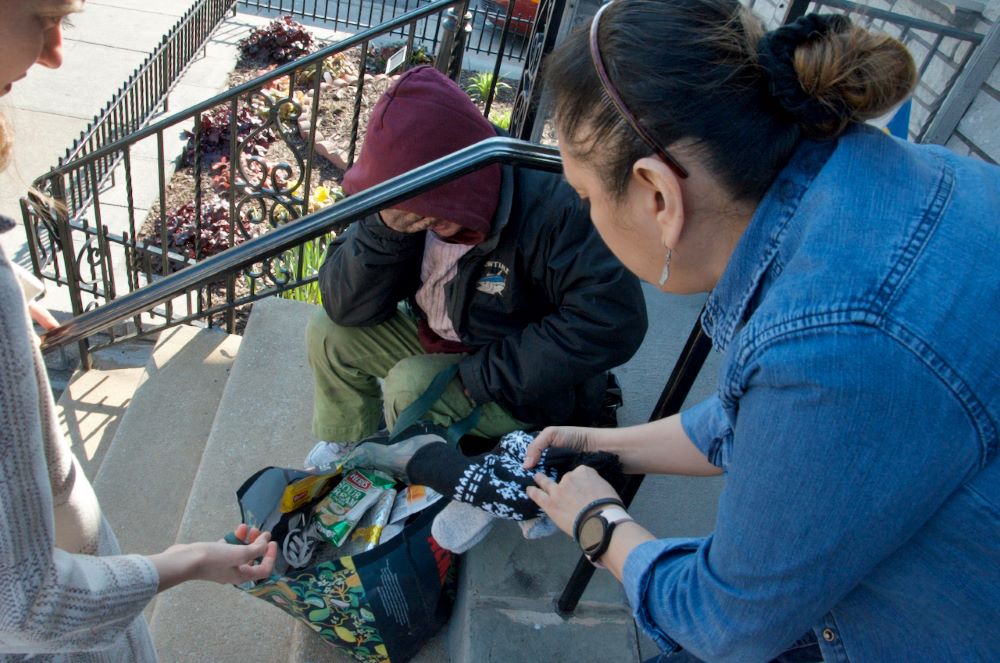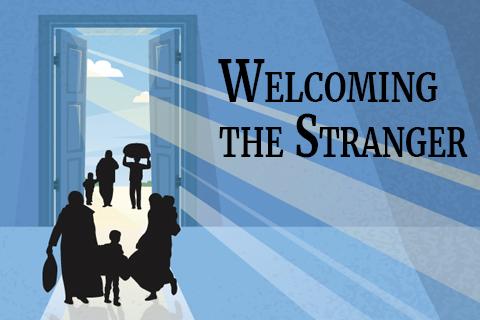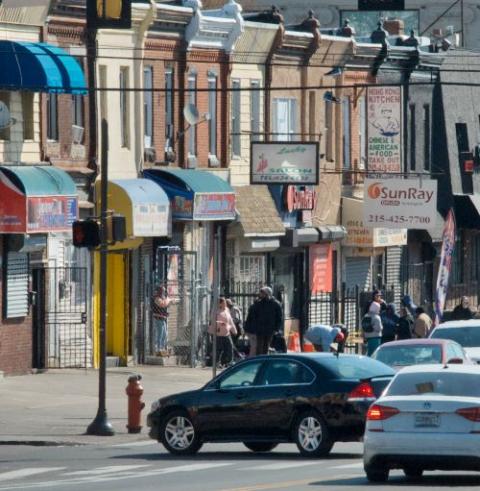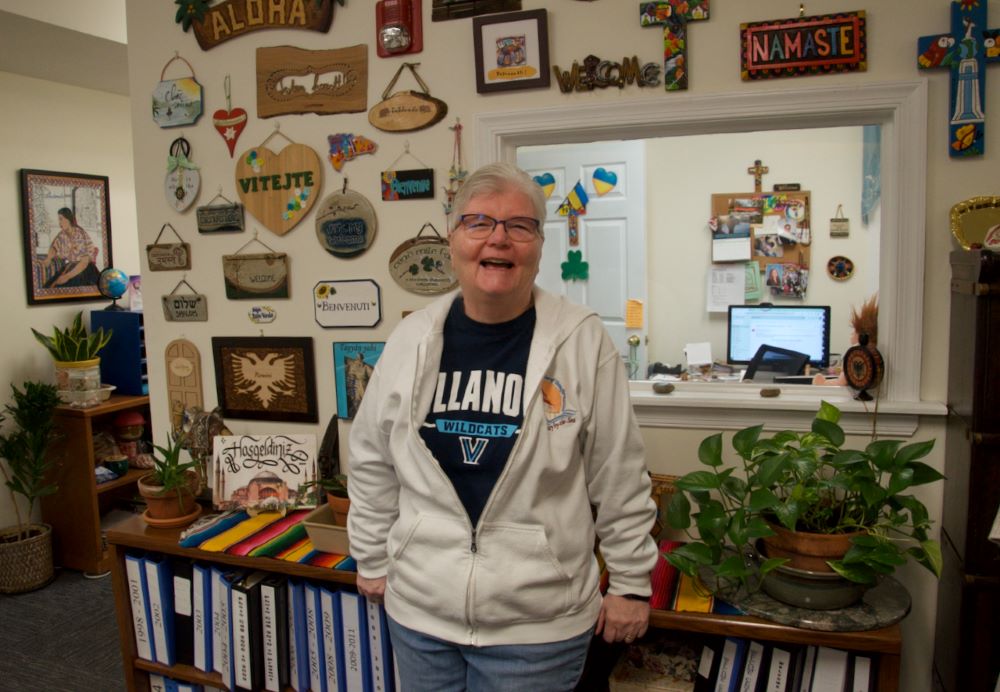
Sisters of St. Joseph Welcome Center Executive Director Olivia Sharkey, left, and a staffer offer warm gloves and a hat to a neighbor suffering from the cold March air outside the center in Philadelphia's Kensington neighborhood. (GSR photo/Dan Stockman)
Editor's note: Global Sisters Report's new series, "Welcoming the Stranger," takes a closer look at women religious working with immigrants and migrants. While we cover this topic often, this series will feature sisters and organizations networking to better serve those crossing borders, global migration trends and the topic of immigration in the upcoming U.S. presidential election.

More than 20 years ago, the Sisters of St. Joseph of Philadelphia were dreaming of a way to help the many Albanian and other Eastern European immigrants that were moving to the area.
Over the next two decades, they transformed that dream into a welcome center that has grown to encompass three row houses in the city's Kensington neighborhood.
The Sisters of St. Joseph Welcome Center offers in-person and online courses in literacy and citizenship and is accredited by the U.S. Department of Justice to assist immigrants with the naturalization process. Some 58 volunteer teachers work with more than 150 students.
"The sisters take their motto seriously to be 'ready for any good work,' " said Executive Director Olivia Sharkey.
Helping new immigrants remains the center's primary objective, but over the years, immigration patterns have changed: The influx of Albanians gave way to Mexicans, a short burst of Ecuadorians, and now many arrive from the Dominican Republic, the sisters said. There have also been Moroccans, Haitians and Venezuelans. Over the summer, 192 students from 16 countries took classes — they spoke six different native languages and used three different alphabets. But wherever they are from, the center is ready to serve.

In Philadelphia's notorious Kensington neighborhood, at all times of the day people can be seen completely bent over at the waist, a side effect of fentanyl use. (GSR photo/Dan Stockman)
In the meantime, the neighborhood around them has changed, too. Kensington is now known as the most notorious open-air drug market on the East Coast, with people buying, selling and using drugs on the sidewalk every minute of the day. Numerous police officers are present if there are incidents or emergencies, but otherwise seem helpless against the tide of addiction.
Sharkey is showing off the facilities when a volunteer tells her a familiar face from the neighborhood is outside in need of help. It's a crisp morning and the woman has been out in the cold all night and needs gloves. Sharkey sends a volunteer for the gloves and makes sure the woman doesn't need anything else. A block away, people on the sidewalk are completely bent over at the waist, a side effect of fentanyl use.
St. Joseph Sr. Pat Madden, the center's outreach coordinator, said efforts to address the problems of Kensington have been both futile and at times even unhelpful.
They try "to clean the neighborhood up, but their understanding of that is moving the unhoused away, not cleaning up the drugs," Madden said. "So the unhoused just get moved from corner to corner."
She said that at times, some have even pushed back against those trying to help, because their efforts encourage people to stay in the neighborhood or cause other problems.
"When people give out food on the weekends, there's a huge mess and they don't pick up the trash," Madden said. "They want them to be in areas where there aren't a lot of people, but then how do they serve those in need?"

Sr. Marian Behrle shows a photo of the Sisters of St. Joseph Welcome Center's origins — a van that would visit different sites to serve the Albanian community and teach literacy classes. Behrle is the center's finance and operations coordinator. (GSR photo/Dan Stockman)
Madden said the center itself has been criticized for giving out food, with some saying it causes unhoused people to stay around instead of moving on.
"If we give out a sandwich once a week, that's not why they’re staying," she said. "The drugs and homelessness are hand in hand."
Two-pronged efforts
Sharkey said the two-pronged efforts of the welcome center — serving recent immigrants and serving their neighbors in need — are not in conflict, but are much more different than they may appear.
"The goal when we work with immigrants is to make them self-sufficient," she said. "We recognize we can't do that for Kensington, but we can meet some of the immediate needs."
So among the classrooms for teaching literacy or citizenship classes, there is a small food pantry and a clothing bank. Last year, the center held 40 literacy classes and celebrated its 350th client becoming an American citizen, and it also held a free medical clinic once a month where you did not need to show any documentation or identification.
Advertisement
Madden said the neighborhood had been changing for years, but the COVID-19 pandemic put the need out into the open where it couldn't be ignored. At the same time, the lockdown meant the center couldn't hold classes. It would be months before they could begin offering online courses, so they looked out their front door to see who needed help and found a populace of unhoused people.
"People didn't have anywhere to go," she said. "And that population has stayed here, it hasn't lessened."
St. Joseph Sr. Marian Behrle, the center's finance and operations coordinator, said the sisters' effort began as a van that would visit four different sites to serve the Albanian community and teach literacy classes. It soon became clear there were other needs to be met, such as navigating the immigration bureaucracy, and they needed a permanent home.
They bought a row house that had been used as a funeral home but had sat empty for five years. After renovations, the welcome center opened in 2003, and eventually they grew to three row houses, which are filled with touches such as the accessibility ramp at the very front, not hidden on the side.
"Everyone comes through the same door," Sharkey said.

Sr. Pat Madden stands before a wall covered with welcome signs given by clients the Sisters of St. Joseph Welcome Center has helped with literacy and citizenship classes. (GSR photo/Dan Stockman)
The center's legacy is a living one: Two of its staffers, both of whom immigrated from Guatemala, are alumni of its programs. Both are U.S. citizens and sent their children to college.
The center has generous donors, but is also supported by the Sisters of St. Joseph of Philadelphia.
"God takes care of us," Behrle said. "The 'ready for any good work' motto — that is our mission."
The changes in the Kensington neighborhood didn't happen overnight, but Sharkey said the center cannot ignore the needs outside its door.
"Our outreach looks very different to our students than our outreach to our neighbors," she said. "This is relational, Gospel work."






